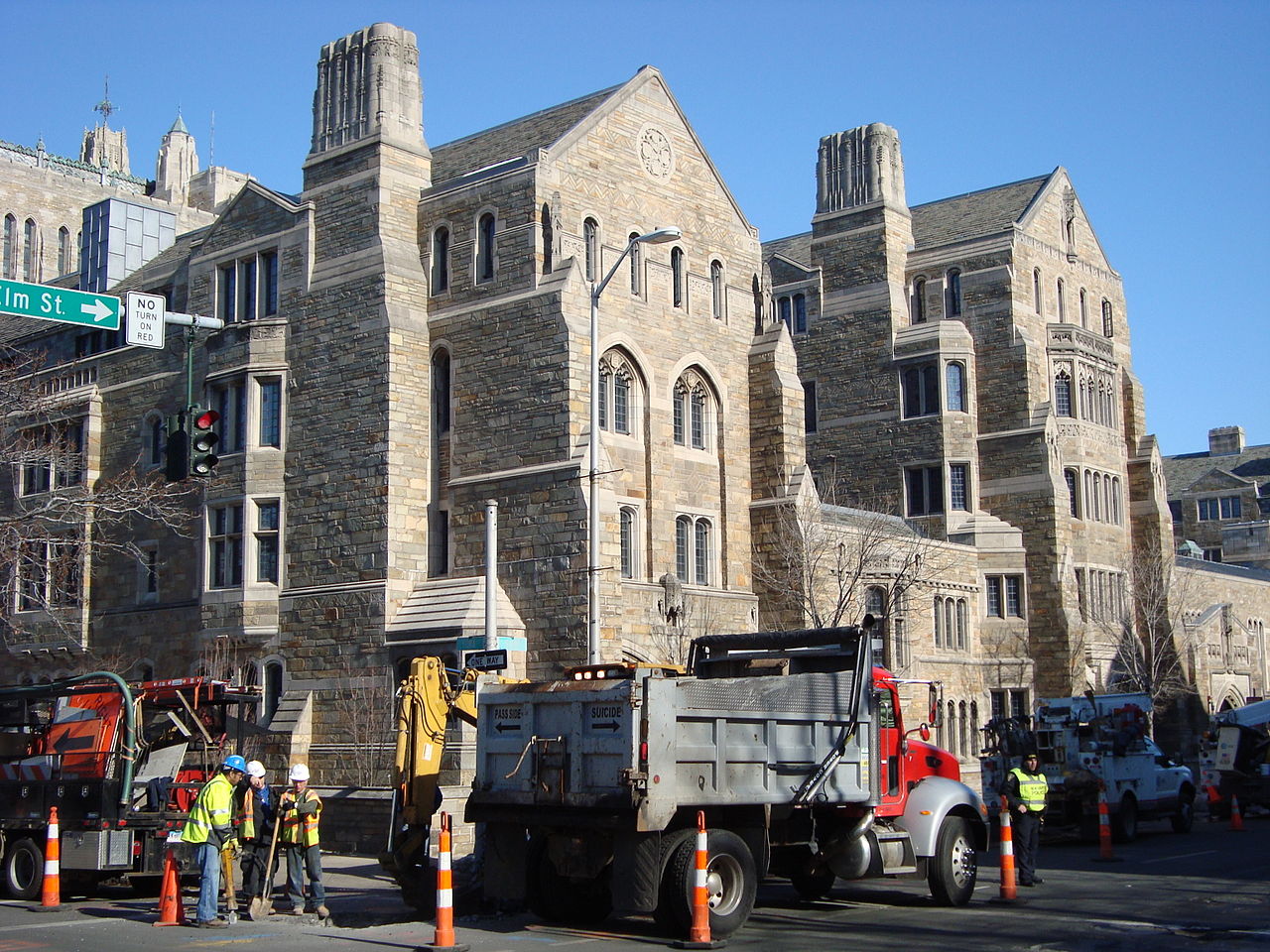December 7, 2015: Yale University has launched a first-of-its-kind pilot program to put a price tag on the use of carbon — with some of the most prominent campus buildings playing a role in the experiment.
Twenty Yale buildings — including the Peabody Museum of Natural History, the School of Management’s Evans Hall, the School of Medicine’s Yale Physicians Building, and Yale Divinity School’s Sterling Divinity Quad — are taking part in the new carbon charge pilot program. So is Woodbridge Hall, the administrative home of Yale President Peter Salovey.
“The carbon charge concept originated as a proposal from Yale undergraduate and graduate students interested in using our campus as a living laboratory for applied research,” said Salovey, who announced the program with Provost Benjamin Polak. “Students were an integral part of the Presidential Carbon Charge Task Force, and many continue to serve in the pilot. Yale’s carbon charge pilot project is an exciting example of how students, faculty members, and staff can collaborate to build a more sustainable and innovative Yale.”
Placing a monetary value on carbon use is considered critical to creating an effective sustainability strategy and is a growing trend in the private sector. The idea is to prompt behavior changes at the individual and organizational levels by putting a price on the carbon dioxide used. Carbon dioxide is a byproduct of all activities that rely on the combustion of fossil fuels for power.
Yale has approximately 350 buildings and uses 3.6 million MMBtu of energy each year. The university generates 60% of its own power at its two co-generation power plants. The remaining electricity is purchased from United Illuminating Co., and natural gas is purchased from Southern Connecticut Gas to power the power plants. The university emits roughly 300,000 tons of carbon dioxide a year. In 2005, Yale pledged to reduce its primary greenhouse gas emissions 43% below 2005 levels by 2020. The university remains on track to meet this ambitious goal.
In 2014, Salovey outlined six sustainability initiatives for Yale, noting that, “Global climate change and its consequences are critical challenges for our time, and Yale has important and necessary roles to play in addressing them.” The initiatives included a $21 million capital investment in energy conservation and greenhouse gas reduction, an expansion of renewable energy, third-party verification of Yale’s greenhouse gas emissions, and the formation of the Presidential Carbon Charge Task Force.
The task force, chaired by Sterling Professor of Economics William Nordhaus, began looking into the feasibility of an internal carbon-pricing program in 2014. Earlier this year, the group presented its recommendations to Salovey. Among those recommendations were that Yale set a carbon charge at the social cost of carbon, currently estimated by the federal government to be $40 per ton of carbon dioxide.
“A key element is that the carbon charge program would expand Yale’s role as a pioneer in research, teaching, and designing practical applications of energy and climate policies,” Nordhaus said. “It would thereby contribute to society’s learning about ways to slow climate change while advancing Yale’s educational mission.”
One novel aspect of Yale’s pilot program is that it is essentially a quartet of experiments to find the best approach to carbon pricing. Each experiment will have five Yale buildings testing a particular manner of carbon pricing:
A market-based model will have Yale units competing with one another to earn rebates.
A target-based model will ask Yale units to meet specified carbon-use goals, in order to earn rebates that are applied to the unit’s annual budget.
An investment model will have Yale units paying a monthly carbon tax for the year. At the end of the year, units will get the money back, with a stipulation that a percentage of the returned money be spent on additional energy-saving measures within their building.
A price signal approach will present Yale units with detailed information about ongoing energy use, along with comparable information about past years’ energy use. The units also will receive regular updates on how their performance would translate into a straight carbon tax payment at the social cost of carbon, purely for informational purposes.
“This will help us arrive at the best model for Yale and allow us to share the lessons we learn with other institutions. That’s a key aspect of the program,” said Ryan Laemel, Yale’s carbon charge project coordinator. “There is no one-size-fits-all approach that works for internal carbon pricing.” (See "How Yale's Carbon Charge Project Works," below.)
The pilot program includes classrooms, residential colleges, laboratories, and offices. Other buildings taking part include Berkeley, Jonathan Edwards, and Pierson residential colleges; the Gilder Boat House; Kroon Hall; and the Yale Health Center.
“It goes beyond simply diversifying the size of the buildings or their carbon footprints. It includes a range of different activity types, budgeting categories, utilities used, building users, and equipment contained,” said carbon charge project manager Jennifer Milikowsky, who is a recent graduate of the joint degree program at the School of Forestry & Environmental Studies and the School of Management. “By doing this we’ll begin to learn how the success of the policies we are testing is influenced by these different characteristics and will help as we continue to expand and improve this project.”
In their announcement, Salovey and Polak noted that feedback from participants and an analysis of the program’s results would inform a broader campus conversation on the topic. “We believe that this pilot project can serve as a model for other institutions, expanding Yale’s role as a pioneer in researching, teaching, and designing climate change solutions,” they said.
Related Stories
Products and Materials | Jan 18, 2023
6 innovative products for multifamily developments
Here are six innovative products for various multifamily developments, including a condominium-wide smart electrical system, heavy-duty aluminum doors, and prefabricated panels.
Adaptive Reuse | Jan 12, 2023
Invest in existing buildings for your university
According to Nick Sillies of GBBN, students are increasingly asking: "How sustainable is your institution?" Reusing existing buildings may help answer that.
Sponsored | Resiliency | Dec 14, 2022
Flood protection: What building owners need to know to protect their properties
This course from Walter P Moore examines numerous flood protection approaches and building owner needs before delving into the flood protection process. Determining the flood resilience of a property can provide a good understanding of risk associated costs.
Green | Dec 9, 2022
Reaching carbon neutrality in building portfolios ranks high for organizations
Reaching carbon neutrality with their building portfolios ranks high in importance among sustainability goals for organizations responding to a Honeywell/Reuters survey of senior executives at 187 large, multinational corporations. Nearly nine in 10 respondents (87%) say that achieving carbon neutrality in their building portfolio is either extremely (58%) or somewhat (29%) important in relation to their overall ESG goals. Only 4% of respondents called it unimportant.
Green | Dec 9, 2022
Newly formed Net Zero Built Environment Council aims to decarbonize the built world
Global management consulting firm McKinsey recently launched the Net Zero Built Environment Council, a cross-sector coalition of industry stakeholders aiming to decarbonize the built world. The council’s chief goal is to collaboratively create new pathways to cut greenhouse gas emissions from buildings.
Adaptive Reuse | Dec 9, 2022
What's old is new: Why you should consider adaptive reuse
While new construction allows for incredible levels of customization, there’s no denying that new buildings can have adverse impacts on the climate, budgets, schedules and even the cultural and historic fabrics of communities.
75 Top Building Products | Nov 30, 2022
75 top building products for 2022
Each year, the Building Design+Construction editorial team evaluates the vast universe of new and updated products, materials, and systems for the U.S. building design and construction market. The best-of-the-best products make up our annual 75 Top Products report.
Seismic Design | Nov 16, 2022
SPC-4D: 7 reasons California hospital building owners should act now to meet seismic compliance
Seismic compliance with the applicable California building codes is onerous and disruptive for building owners, especially for a building in the heavily regulated sector of healthcare. Owners of older buildings that house acute care services have a big deadline on the horizon—Jan. 1, 2030, the cutoff date to upgrade their buildings to SPC-4D.
Energy-Efficient Design | Nov 14, 2022
How to achieve net zero energy in five steps
Martine Dion and Ethan Seaman share net zero energy best practices with owners and developers.
Resiliency | Nov 8, 2022
Oregon wildfire risk law prompts extensive backlash from property owners
A bipartisan bill aimed at protecting property owners from wildfires that was passed by the Oregon legislature has prompted a strong backlash.
















